Back in early 2023, I set out to build my own dedicated router/firewall to replace my Ubiquiti EdgeRouter ER-X. It was a decent little box, but I wanted something more capable, powerful, and expandable. At that point in time, I did a very initial test of OPNsense vs pfsense and decided to move forward with OPNsense.
Fast forward several years later I did an update review, however I wanted to do a more in-depth test of OPNsense vs pfsense to break down the features, user interface, VPN options, hardware options, and community support to decide what I think is the best router software and share the info to help you make a decision as well.
Choosing between OPNsense and pfSense often depends on how you want to build and manage your network. pfSense has increasingly focused on pairing its software with official hardware, while OPNsense remains popular with DIY and open-source enthusiasts.
- Software Versions
- Setup of pfSense in Virtual Machine
- User Interface
- Firewall Capabilities
- VPN
- Intrusion Detection System (IDS) / Intrusion Prevention System (IPS)
- Software Philosophy
- Hardware
- Documentation and Community Support
- Resource Usage
- Summary of Comparison
- Final Thoughts
Software Versions
| OPNsense Version | pfSense Version |
| OPNsense 25.1 | 2.8.0-RELEASE |
Setup of pfSense in Virtual Machine
As I mentioned above, I am using OPNsense bare-metal as my current router, for testing, I used a virtual machine for my pfsense testing so I didn’t disrupt my network (I hoped). First time launching pfsense, it booted up with the WAN address the same as my current default gateway, so it took down my network. No worries, just powered of the virtual machine and it was resolved, but now I had to configure it to work on my computer, but still access the webui.
| Virtualbox Network | pfsense adapater | |
| Adapter 1 | Not attached | No Configuration |
| Adapter 2 | Bridged Adapter | IP from your local network |
User Interface
Lets walk through the user interface between OPNsense vs pfSense.
OPNsense Dashboard
Overall, I find the OPNsense user interface to be cleaner and more modern compared to other firewall platforms. It offers a well-organized layout with easy navigation and built-in monitoring tools like CPU and traffic charts right on the dashboard. The menu being on the left and easily to expand and collapse menus or use the search to find what you are looking for.
Initially, I thought it was missing a dark mode, which would have been a nice touch for nighttime use or lower eye strain. After digging into the settings, I was pleasantly surprised to find that dark mode is actually available, although it isn’t immediately obvious at first glance.
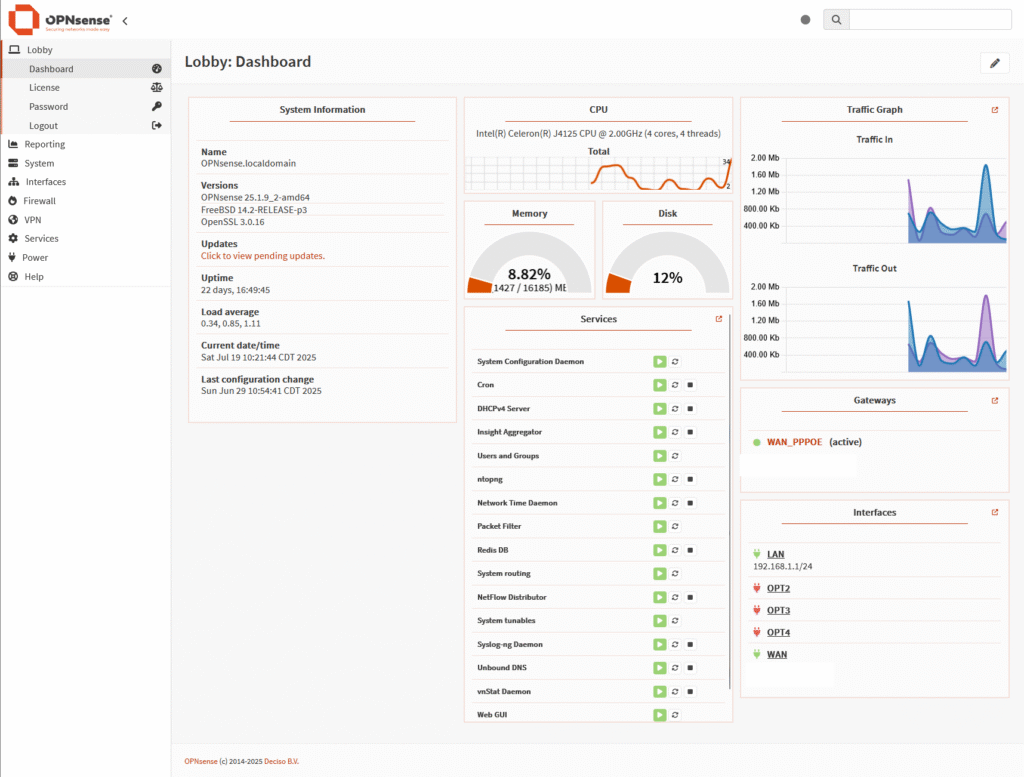
pfSense Dashboard
The pfSense dashboard is straightforward and includes the essentials, but it lacks modern or dynamic widgets. The main menu is positioned at the top, making it easy to see the contents of each section. While the breadcrumb navigation helps a bit when drilling down into menus, the overall interface feels a bit old-school and clunky compared to more modern platforms.
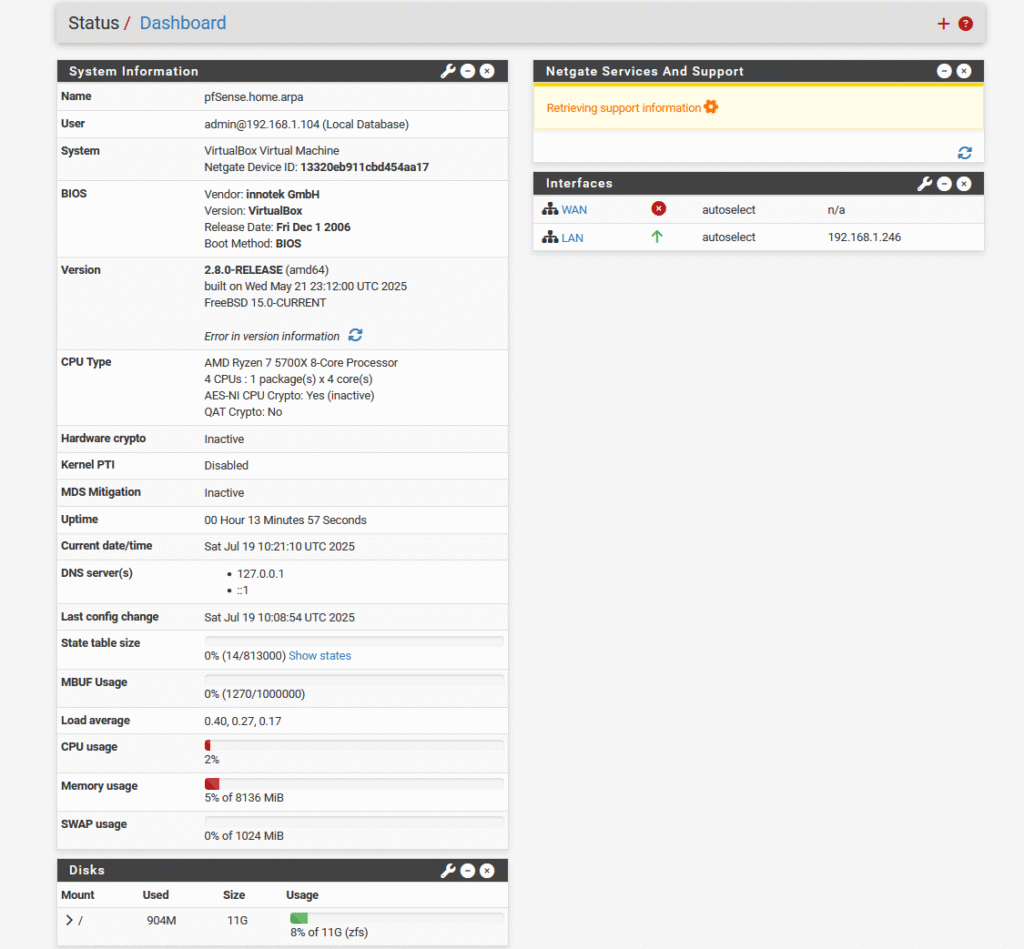
Firewall Capabilities
When it comes to creating and managing firewall rules, I think OPNsense and pfSense are pretty similar. Both have a familiar layout with clear rule sets, easy interface selection, and support for aliases to keep things organized. The UI is different between the two, but the overall process of setting up and reviewing rules feels about the same.
OPNsense Firewall
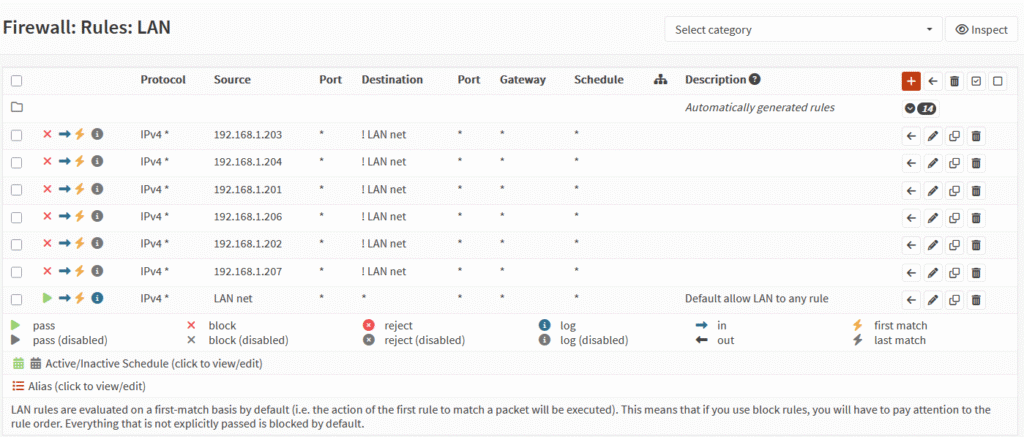
pfSense Firewall
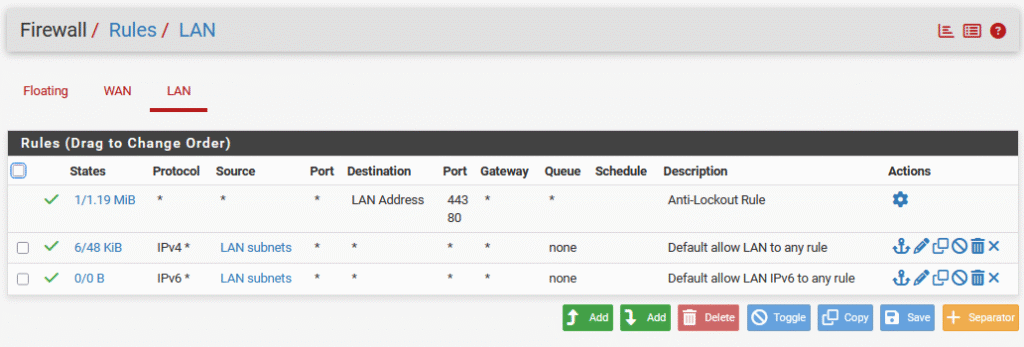
VPN
OPNsense VPN
OPNsense includes three built-in VPN options right out of the box: IPsec, OpenVPN, and WireGuard. This gives you plenty of flexibility, whether you’re setting up site-to-site connectivity, remote access, or a lightweight modern VPN. While I haven’t personally configured these VPNs yet, OPNsense does provide built-in tools and documentation to guide the process. If you’re planning to set one up, I’d recommend following a well-written online guide or the official documentation to ensure everything is configured securely and correctly.

pfSense VPN
pfSense also includes multiple built-in VPN options out of the box, including IPsec, Layer 2 Tunneling Protocol (L2TP), and OpenVPN. These options cover common use cases such as remote access and site-to-site VPN connections. While I haven’t personally set up any of these VPNs yet, pfSense offers extensive documentation and community resources to help guide the setup process. If you’re planning to configure a VPN, following a reputable online guide or the official pfSense documentation is the best way to ensure a secure and reliable setup.

Intrusion Detection System (IDS) / Intrusion Prevention System (IPS)
OPNsense IDS/IPS
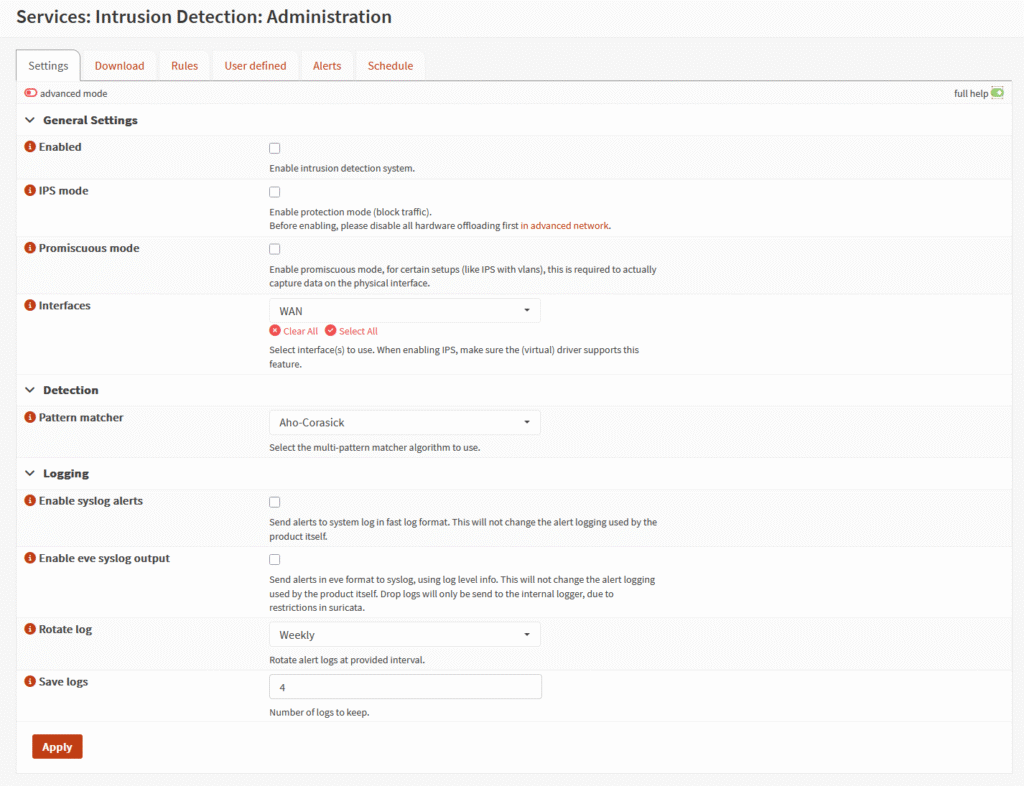
pfSense IDS/IPS
Out of the box, pfSense doesn’t have anything, but you can easily install add-on packages such as Snort and Suricata that are popular IDS and IPS respectively.
Software Philosophy
There has been some drama between the two and if you are interested, suggest reading this article : https://www.xda-developers.com/why-use-opnsense-over-pfsense-dont-trust-netgate/
OPNsense Software
OPNsense and pfSense have an intertwined history. OPNsense was forked from pfSense in 2015, and pfSense was forked from m0n0wall, so you can they both are derived from m0n0wall.
pfSense Software
The pfSense project began in 2004 as a fork of the m0n0wall project. While pfSense is open source, they do some some closed source code for their commercial/enterprise efforts.
Hardware
If you’re interested in running officially supported hardware, both OPNsense and pfSense offer solid options. Either way, going with vendor-supported hardware can offer better stability, updates, and peace of mind for critical setups.
OPNsense Hardware
- Mini PCs: A popular choice thanks to low power consumption and multiple Ethernet ports, making them ideal for dedicated firewall and router setups.
- Older Desktops or Servers: A cost-effective option if you already have spare hardware. Adding a dual or quad NIC allows for proper LAN, WAN, and VLAN separation, though power usage is typically higher.
- Official OPNsense Hardware: Turnkey mini computer to rackmount firewalls designed and supported by OPNsense. These offer reliability and support but come at a higher price point.
- Virtualized OPNsense: Running OPNsense on platforms like Proxmox or ESXi is flexible and budget-friendly if you already have capable hardware, with added benefits like snapshots and easy backups.
I have a full post dedicated to hardware recommendations for OPNsense.
pfSense Hardware
The hardware options for pfSense are going to be similar to the OPNsense options above. In general pfSense heavily pushes you toward their Netgate hardware. From a business prospective makes sense, but if you are a DIYer like me, it might not be the best option. If you are looking for a low cost official hardware supported solution, pfsense has cheapest option.
Documentation and Community Support
Both platforms offer detailed documentation and active community support. I’ve included links to the main documentation pages for each below if you want to dive deeper.
OPNsense Documentation
pfSense Documentation
https://docs.netgate.com/pfsense/en/latest/index.html
Resource Usage
I wanted to perform a resource usage, but with comparing bare-metal to virtual machine isn’t an apples to apples comparison, so maybe something I look at expanding in the future.
Summary of Comparison
| OPNsense | pfsense | |
| Firewall Capabilities | Tied | Tied |
| VPN Options | IPsec, OpenVPN, WireGuard | IPsec, Layer 2 Tunneling Protocol (L2TP), OpenVPN |
| User Interface | Updated and newer | Functional, but older |
| IDP/IPS | Yes | Optional install |
| Software Philosophy | Open and straightforward | free community edition and a proprietary Plus |
| Official Hardware available | Yes | Yes |
| Documentation and Community Support available | Yes | Yes |
Final Thoughts
After running OPNsense on a bare-metal setup for over two years, I still feel confident in the decision I made. While both OPNsense and pfSense offer strong features, solid community support, and official hardware options, OPNsense has stayed more aligned with the DIY and open-source community. Revisiting both platforms now, it’s clear that their core strategies haven’t changed much. While both offer similar capabilities in terms of firewall rules, VPN support, and documentation, I continue to prefer OPNsense for its cleaner, more modern user-friendly interface and support of the DIY community. At the end of the day, both platforms are capable and for most people, but for a hands-on, more flexible experience, I’m glad I went with OPNsense.
2 thoughts on “OPNsense vs pfSense : Full Comparison of Features, UI, and Hardware”